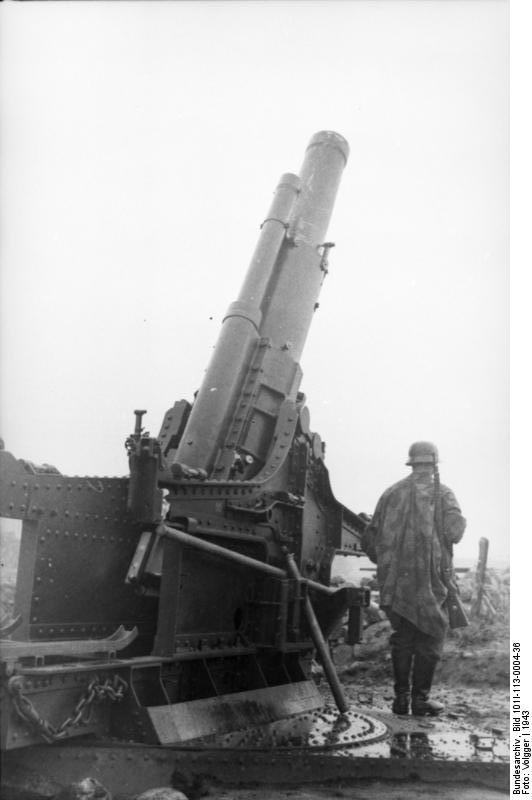Skoda 220 mm howitzer, German designation 22 cm Mörser 538(j)/(p).
Whereas the Skoda vz 37 howitzer was a completely new design, the slightly earlier Skoda 220-mm howitzer was very much a product that had its origins in earlier days. In the period up to 1918, when the Skoda works were the largest armament producers for the Austro-Hungarian Empire, the Pilsen works had been only slightly behind the German Krupp concern in the manufacture of really heavy artillery, and the heavy Skoda howitzers were second to none in overall efficiency. Thus when the Skoda works started production again the ‘classic’ howitzer was one of its main products.
However, the accent was no longer on heavy calibres alone. Despite their dreadful efficiency in demolishing fortifications, such equipments were ponderous beasts to move and their rate of fire was extremely slow. They were also fearfully expensive, so when some of the new nations formed after the Treaty of Versailles started to arm themselves against a difficult future they still wanted heavy artillery, but not too heavy, An interim calibre of about 220 mm (8.66 in) was still about right for the destruction of heavy structures, but the howitzer itself need not be too ponderous. Skoda sensed the market and produced the required 220-mm design incorporating much of its considerable experience in such matters, and it was not long before customers arrived.
The first was Yugoslavia, formed from several of the pre-World War I Balkan states. The new nation decided it had much to fear from its neighbours, and thus was involved in numerous purchases of weapons of all kinds throughout Europe. Yugoslavia was a good customer of Skoda, and in 1928 took delivery of a batch of 12 220-mm Skoda howitzers under the designation M.28. Another customer was Poland, which ordered no less than 27, These Polish howitzers featured prominently in many pre-war propaganda photographs of the Polish army, all with one feature in common: in all of these photographs the breech mechanism was obscured in some way, usually by a soldier, as part of the normal Polish security procedure in any artillery illustration intended for publication.
It did the Poles no good, for in 1939 the Germans invaded and captured or destroyed the entire Polish gun park. The unfortunate Yugoslavs followed just over a year later. Thus the Germans found themselves with a useful quantity of 220-mm howitzers, which promptly became part of the German army’s inventory. There was not much of a role for such a relatively heavy piece in the German Blitzkrieg concept, so the captured howitzers were distributed mainly to garrison and static units in the occupied territories. Some of these were as distant as Norway, but in late 1941 a number of these howitzers were gathered together and added to the siege train that was sent to invest the fortress of Sevastopol in the Crimea. This was the last classic investment of a fortress by the age-old method of assembling and using a siege train, and the fortress fell after the Skoda howitzers had played a useful part, Thereafter they were once more scattered and saw little use during the remainder of the conflict.
Specification
Skoda 220-mm howitzer
Calibre: 220 mm (8.66 in)
Length of piece: 4.34 m ( 14 ft 2.8 in)
Weight: travelling 22700 kg (50,045 lb) and in action 14700 kg (32,408 lb)
Elevation: +40° to +70°’
Traverse: 350°
Muzzle velocity: 500 m ( 1,640 ft) per second
Maximum range: 14200 m (15,530 yards)
Shell weight: 128 kg (282.19 lb)
